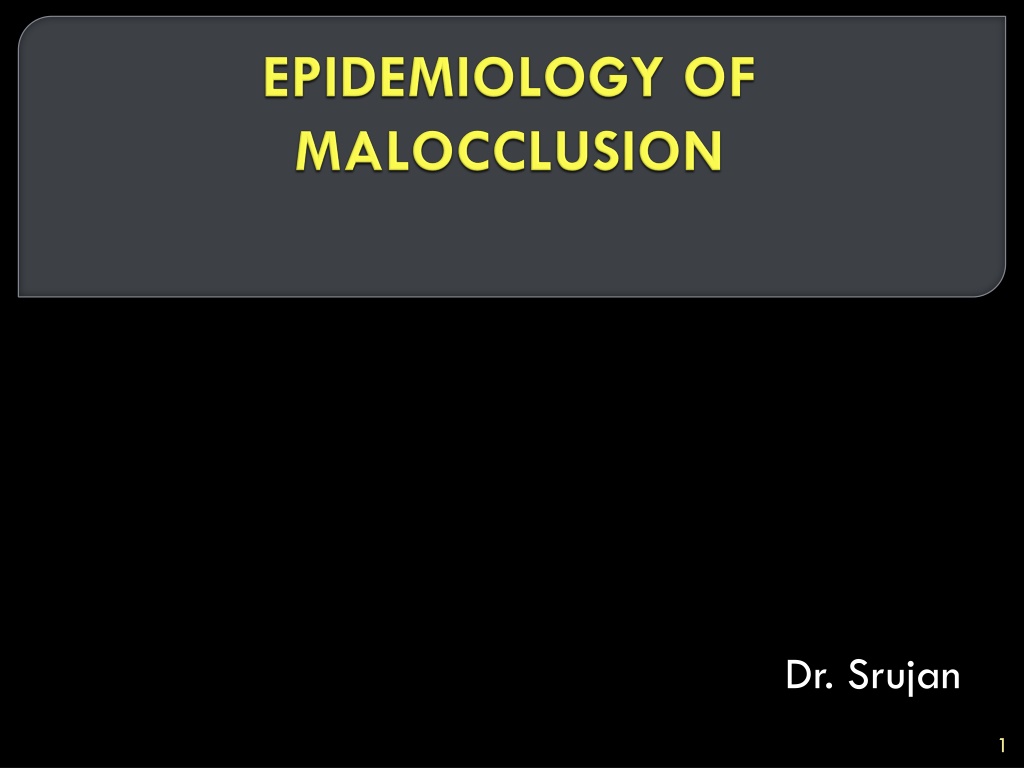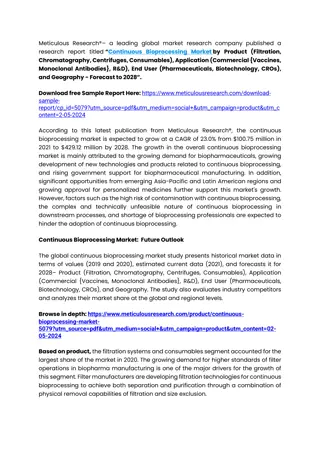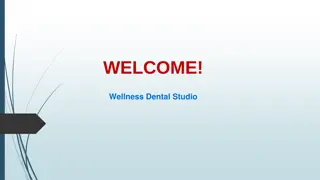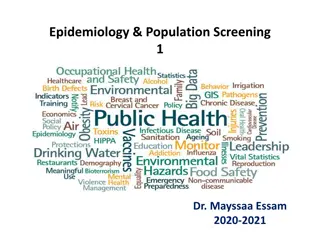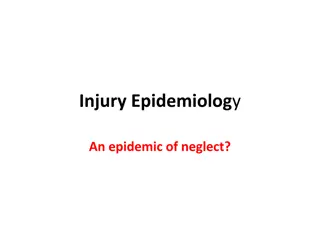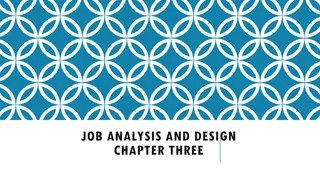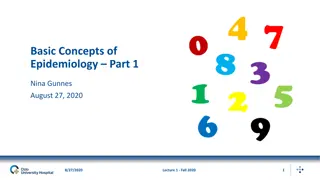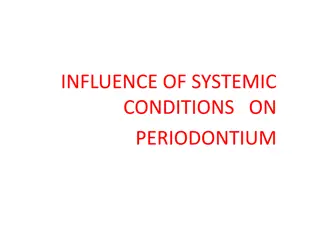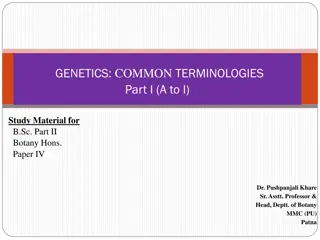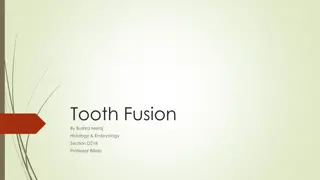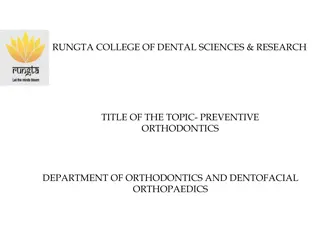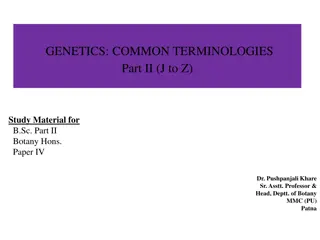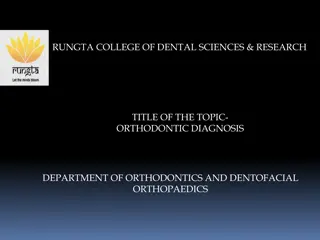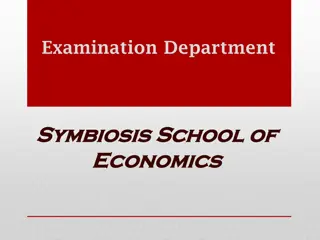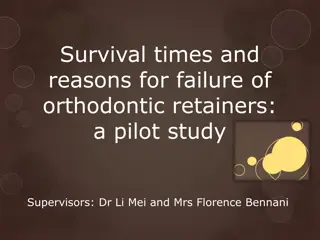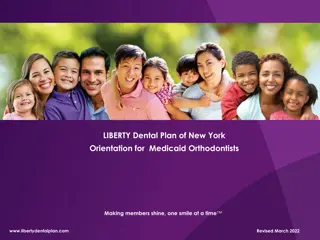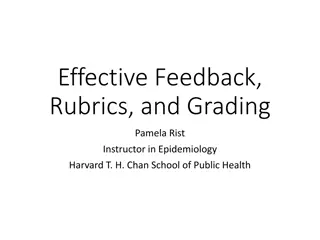Understanding Malocclusion: Epidemiology, Terminologies, and Orthodontic Concepts
This comprehensive content delves into the epidemiology of malocclusion, covering determinants, distribution, measurement, prevalence, and global versus Indian scenarios. It explains key terminologies like overjet, overbite, and crossbite, along with concepts such as centric occlusion and orthodontics. The text explores the etiological factors, unfavorable sequelae, and WHO recommendations related to malocclusion, emphasizing the importance of preventive orthodontics. Additionally, it traces the history and definition of orthodontics, shedding light on its crucial role in studying jaw and teeth development.
Download Presentation

Please find below an Image/Link to download the presentation.
The content on the website is provided AS IS for your information and personal use only. It may not be sold, licensed, or shared on other websites without obtaining consent from the author. Download presentation by click this link. If you encounter any issues during the download, it is possible that the publisher has removed the file from their server.
E N D
Presentation Transcript
Terminologies Epidemiology of Malocclusion Determinants- etiological factors Distribution- Global / Indian scenario Measurement Types/ Classification Unfavorable Sequelae of malocclusion Prevalence of malocclusion WHO recommendations Preventive Orthodontics Conclusions References 2
Overjet- extension of the incisal or buccal cusp ridges of the upper teeth labially or buccally to the incisal margins and ridges of the lower teeth when the jaws are closed normally. Overbite-the extension of the upper incisor teeth over the lower ones vertically when the opposing posterior teeth are in contact. Crossbite-malocclusion in which the mandibular teeth are in buccal version (or complete lingual version in posterior segments) to the maxillary teeth. 3
Centric occlusion-is the term used to describe the position of the lower jaw when the teeth are fully occluded (together). This varies from person to person depending upon the number and position of teeth in each jaw. Centric relation- is the mandibular jaw position in which the head of the condyle is situated as far superior and ANTERIORLY as it possibly can within the articular eminence. 5
Centric occlusion Centric relation 6
The term orthodontia was apparently used first by the Frenchman Le Foulan in 1839. The name of the specialty orthodontics comes from the two Greek words ortho meaning right or straight odontos meaning the tooth, ics meaning the science. The definition given by the British society for the study of orthodontics in 1922. 7
Definition- Orthodontics includes the study of the growth and development of the jaws and face particularly; and the body generally, as influencing the position of the teeth; the study of the action and reaction of internal and external influences of the development, and the prevention and correction of arrested and perverted development. 8
Dental occlusion is a genetic feature of physical anthropology which varies in individuals just as does blood grouping or color of the eye. Malocclusion is a complex morphological and functional phenomenon manifested in a disharmony of two or more features of jaws, teeth and soft tissue. 9
Epidemiological study regarding malocclusion using various indices in turn help to assess the frequency, distribution and determinants associated with different type and severity of malocclusion among the population groups. 10
General Factors: 1. Heredity- it is quite logical to assume that offspring inherit quite a few attributes from their parents. The child may inherit conflicting traits from both the parents resulting in abnormalities of the dento facial region. general 2. Congenital- local 11
Developmental defects are malformation seen at the time of the birth. General Congenital defects- Abnormal state of mother during pregnancy. Malnutrition. Infectious Disease. Accidents during pregnancy & child birth. Local congenital factors Abnormalities of jaw due to intra- uterine position Clefts of the lips and palate Macro and Microglossia 12
Microglossia Malnutrition 13
3. Environmental - Prenatal maternal diet, metabolism, maternal infection such as German measles & use of certain drug during pregnancy such as thalidomide can cause gross congenital deformities including clefts. Post natal during forceps delivery result in injury to TMJ area which can undergo Ankylosis. Cerebral palsy it caused by muscle In coordination. Patient can have malocclusion due to loss of muscle imbalance. 14
4. Predisposing metabolic climate and disease. Endocrine imbalance- due to certain endocrinal disease, infectious condition and metabolic disturbance can predispose to malocclusion. Hypothyroidism Dec. Ca deposition in bone & teeth, Marked delay in tooth bud formation, delayed carpel and epiphyseal calcification. Hyperthyroidism- inc. rate of maturation, inc. in metabolic rate. Hypoparathyroidism- change in Ca metabolism, can cause delayed eruption & hypo plastic teeth. 15
Hyperparathyroidism- inc. blood Ca. demineralization of bone. Metabolic disturbances- Acute febrile ds. Believed to slow down the pace of growth & development 5. Dietary problems - Nutritional deficiencies- rickets, scurvy & beri-beri can produce severe malocclusion. 16
6. Abnormal Pressure habits Abnormal Sucking Tongue thrust Lip and nails biting, Mouth breathing 17
7. Accidents & trauma- Children are highly prone to injuries of the dento facial region during the early years of life when they learn to crawl, walk during the play. 18
Local Factors: 1. Anomalies of tooth tooth size- an increase in size of the teeth result in crowding & smaller lead to spacing tooth shape- Peg shaped lateral incisors is often accompanied by spacing & migration of teeth. 2. Abnormal frenal attachments- it is associated with maxillary midline spacing 19
maxillary midline spacing 20
3. Premature loss - loss of teeth before its permanent successor erupt which result in migration of adjacent teeth thus can prevent eruption of permanent successor. Prolonged retention- deciduous teeth that fail to resorb will prevent normal eruption. Anomalies of tooth 4. Ankylosis, dental caries, improper dental Restorations, etc. 21
1.Physiological Problems the one who suck his finger beyond time. Commonly referred by friend (Bugs Bunny, bird beak) 2.Oral function - Difficulty in chewing - Difficulty in speech - Clenching and grinding 22
Clenching and grinding Difficulty in speech 23
3.Temperomandibular Joint problems: - Pain in and around TMJ - Muscle fatigue and spasm Frequency seen with Occlusal prematurities and deepbite 24
4.Greater susceptibility to trauma, periodontal disease or tooth decay - Trauma to upper incisors in Class II - Extreme overbite - where lower incisors contact the palate -cause significant tissue damage. - Occlusal trauma - periodontal disease 25
While dental caries has been regarded as the major dental disease through out the world , malocclusion was a close runner up. With fluoridation, there is a good chance for significant reduction or even elimination of caries as a problem. Various studies have been done in an attempt to make an epidemiologic malocclusion. registration of 27
Reported prevalence of malocclusion in mixed dentition or in permanent dentition Authors Years Nationality Sample Age Malocclusion Prevalence Hellman 1921 American long beach 346 10-15 69.6 Taylor 1928 German Bonn 1000 145 55.4 Massler & Frankel 1935 Australian 129 14 66.6 Newman 1956 American Newark, N.J. 3355 6-13 51.9 Mills 1966 American Suitland, M.D. 1455 13-14 82.5 28
Popovich & Grainger 1959 Canadian Burlington 300 12 88.0 Goose et .al 1957 English Urban & rural 1588 `7-15 Urban-49.8 Rural-37.9 Miller & Hobson 1961 English Manchester 199 14 38.5 Biljstra 1958 Dutch 940 School children 66.5 Andrik 1954 Slovakia 2509 10-15 49.0 Gergely 1958 Hungarian 2349 7-8 58.7 29
The prevalence of malocclusion among Indian children has been reported to be as low as 19.6% in Madras by Miglani D.C et al in 1965 and as high as 90% in Delhi by Sidhu S.S in 1968. India exhibit a low incidence of variation in molar relation both in the mesial and distal relationship. Class 111 malocclusion is also much less prevalent in India compared to USA, Netherlands and Kenya. 31
Authors Year Sample Region Prevalence Shourie 1942 13-16 Punjab 50% Shaikh 1960 6-13 Bombay 68% Miglani 1963 15-25 Madras 19.6% Shaikh &Desai 1966 7-21 Bombay 72.9% 33
Authors Year Sample Region Prevalence Sidhu 1968 6-30 Delhi 90% Jacob 1969 12-15 Trivandrum 44.97% Nagaraja Rao 1980 5-15 Bangalore 85.7% Jalili 1989 6-14 Mandu district 14.4% Kharbanda 1991 5-13 Delhi 10-18% 34
Malocclusion can be broadly divided into: Intra arch malocclusion- that include variation in individual tooth position and malocclusion affecting a group of teeth within an arch. Inter arch- malocclusion that compromises of malrelation of dental arches to one another upon skeletal bony bases which may themselves be normally related. 35
Skeletal malocclusion- which involves the underlying bony bases. A skeletal malocclusion occurs when the upper and lower jaws don't line up correctly. Overbite: Upper jaw protrudes or lower jaw recedes (or both). Underbite: Lower jaw protrudes. 36
Intra arch malocclusion- can include condition like spacing or crowding. Some commonly seen individual malpositions: Distal inclination Distal inclination crown of the tooth is tilted. Mesial inclination Mesial inclination Lingual inclination Lingual inclination Buccal inclination Buccal inclination 37
Mesial displacement Mesial displacement- - crown of the tooth is tilted. Distal displacement Distal displacement- - body movement in distal direction away from midline Lingual displacement Lingual displacement- - tooth is displaced in lingual direction Buccal displacement Buccal displacement tooth is moved in labial direction Rotations Rotations- - tooth movements along its long axis. 38
Inter arch malocclusion- Can occur in sagittal, vertical or in the transverse planes of space. Sagittal planes- (pre normal occlusion)- condition where the lower arch is more forwardly placed when the patients bites in centric occlusion. (Post Normal occlusion)- condition where the lower arch is more distally placed when the patients bites in centric occlusion 39
Inter arch malocclusion vertical interarch dental separation between the maxillary and mandibular incisors when the posterior teeth are in terminal occlusion. 40
Vertical plane- include deep bite and open bite. Deep bite- condition where there is excessive vertical overlap between the upper and lower anterior. Open bite- conditions where no vertical overlap between the upper and lower teeth. It can be in anterior or posterior region. 41
open bite Deep bite 42
Skeletal Malocclusion Can occur due to abnormalities in the maxilla or mandible. In sagittal planes there is forward placement of jaw referred to as prognathism while retrognathism refer to as backward placement of jaw. In transverse planes there is usually narrowing or widening of jaw. 43
In vertical planes abnormal variations in the vertical measurements of the jaw can affect the lower facial height. 44
Preventive Orthodontics- is that part of orthodontic practice which is concerned with the patient and parent corporation, supervision of the growth and development of the dentition and the craniofacial structures. Preventive orthodontics is a long range approach and it is largely responsibility of the general dentist . 45
The following are the procedure undertaken in preventive orthodontics: * Parent education * Caries control * Care of deciduous dentition * Management of ankylosed teeth * Maintenance of quadrant wise tooth shedding time table * Check up of oral habits * Occlusal equilibration * Extraction of supernumery teeth * Space maintenance 46
The expecting mother should be educated on matters such as nutrition to provide an ideal environment for the developing foetus. Soon after the birth, the mother should be educated on proper nursing & care of the child. The mother should be advised on physiologic nipple than conventional nipple because physiologic nipple are designed to permit suckling of the milk which more or less resembles the normal functional activity as in breast feeding. 47
Preventive orthodontics include care of the deciduous dentition by way of prevention and timely restoration of the carious teeth. The deciduous teeth are excellent natural space maintainers until the developing permanent teeth are ready to erupt into the oral cavity. Simple preventive procedures such as application of topical fluoride & pit and fissures sealant help in preventing caries. 48
Presence of supernumerary and supplemental teeth can interfere with the eruption of nearby normal teeth. They can deflect adjacent teeth to erupt in abnormal positions. Presence of an unerupted mesiodens prevents the two maxillary central incisors from approximating each other. Thus supernumerary teeth should be identified and extracted before they cause displacement of other teeth. 49
